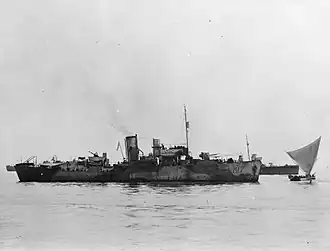HMS Amaranthus (K17)
 HMS Amaranthus
| |
| History | |
|---|---|
| Name | HMS Amaranthus |
| Ordered | 21 September 1939 |
| Builder | Fleming & Ferguson, Paisley |
| Laid down | 4 May 1940 |
| Launched | 17 October 1940 |
| Commissioned | 12 February 1941 |
| Decommissioned | 1946 |
| Identification | Pennant number: K17 |
| Fate | Sold in 1946. Broken up at Hong Kong in 1953. |
| General characteristics | |
| Class & type | Flower-class corvette |
| Displacement | 925 long tons |
| Length | 205 ft (62 m) o/a |
| Beam | 33 ft (10 m) |
| Draught | 11 ft 6 in (3.51 m) |
| Propulsion |
|
| Speed | 16 kn (30 km/h) |
| Range | 3,500 nmi (6,500 km) at 12 kn (22 km/h) |
| Complement | 85 |
| Sensors & processing systems |
|
| Armament |
|
| Service record | |
| Commanders: | Lt. Nicholas Bryan John Stapleton, RNR (January 1941 to August 1941); T/Lt. Walter Smith Thomson, RNR (August 1941 to June 1943); T/A/Lt.Cdr. William Godfrey Pardoe-Matthews, RNR (June 1943 to November 1944); T/A/Lt.Cdr. John Maurice Baldry, RNVR, (November 1944 to decommissioning) |
| Operations: | Battle of the Atlantic |
HMS Amaranthus (K17) was a Flower-class corvette of the Royal Navy.[1] She took part in the Second World War, being involved in escorting convoys from West Africa to the United Kingdom from May 1941 onwards.[2]
Design and construction
The Flower-class arose as a result of the Royal Navy's realisation in the late 1930s that it had a shortage of escort vessels, particularly coastal escorts for use on the East coast of Britain, as the likelihood of war with Germany increased. To meet this urgent requirement, a design developed based on the whale-catcher Southern Pride - this design was much more capable than Naval trawlers, but cheaper and quicker to build than the Hunt-class destroyers or Kingfisher-class sloops that were alternatives for the coastal escort role.[3][4]
The early Flowers, such as Amerantus were 205 feet 0 inches (62.48 m) long overall, 196 feet 0 inches (59.74 m) at the waterline and 190 feet 0 inches (57.91 m) between perpendiculars. Beam was 33 feet 0 inches (10.06 m) and draught was 14 feet 10 inches (4.52 m) aft.[5][6] Displacement was about 940 long tons (960 t) standard and 1,170 long tons (1,190 t) full load. Two Admiralty Three-drum water tube boilers fed steam to a Vertical Triple Expansion Engine rated at 2,750 indicated horsepower (2,050 kW) which drove a single propeller shaft. This gave a speed of 16 knots (18 mph; 30 km/h).[6] 200 tons of oil were carried, giving a range of 4,000 nautical miles (4,600 mi; 7,400 km) at 12 knots (14 mph; 22 km/h).[6]
Design armament was a single BL 4-inch Mk IX naval gun forward and a single 2-pounder "pom-pom" anti-aircraft cannon aft, although the pom-poms were not available until 1941, so early ships were completed with improvised close-range anti aircraft armament such as Lewis guns or Vickers .50 machine guns instead.[7][8]
Amaranthus was one of a group of ten Flower-class corvettes ordered by the Admiralty on 21 September 1939.[9][10] The ship was laid down at the Scottish shipbuilder Fleming and Ferguson's Paisley shipyard as Yard number 563 on 4 May 1940.[9][10][11] She was launched on 17 October 1940 and completed on 12 February 1941.[9][10]
Wartime service
References
- Citations
- ^ Colledge, J. J. (2006). Ships of the Royal Navy : the complete record of all fighting ships of the Royal Navy from the 15th century to the present. Ben Warlow. London: Chatham. ISBN 978-1-86176-281-8. OCLC 67375475.
- ^ "HMS Amaranthus (K 17) of the Royal Navy - British Corvette of the Flower class - Allied Warships of WWII - uboat.net". uboat.net. Retrieved 25 August 2022.
- ^ Friedman 2008, pp. 133–134
- ^ Lambert & Brown 2008, pp. 3–4
- ^ Friedman 2008, p. 324
- ^ a b c Lambert & Brown 2008, p. 4
- ^ Elliott 1977, p. 184
- ^ Lambert & Brown 2008, p. 73
- ^ a b c Friedman 2008, p. 341
- ^ a b c Lambert & Brown 2008, p. 67
- ^ "Amaranthus". Scottish Built Ships. Caledonian Maritime Research Trust. 2022. Retrieved 26 August 2022.
- Elliott, Peter (1977). Allied Escort Ships of World War II: A complete survey. London: Macdonald and Jane's Publishers. ISBN 0-356-08401-9.
- Friedman, Norman (2008). British Destroyers and Frigates: The Second World War and After. Barnsley, UK: Seaforth Publishing. ISBN 978-1-84832-015-4.
- Lambert, John; Brown, Les (2008). Flower-Class Corvettes. St. Catharines, Ontario, Canada: Vanwall Publishing. ISBN 978-1-55068-986-0.
- "HMS Amaranthus (K 17) of the Royal Navy - British Corvette of the Flower class - Allied Warships of WWII - uboat.net". uboat.net. Retrieved 25 August 2022.
Further reading
- Admiralty; Board of Admiralty (1799–2008). "Admiralty, and Ministry of Defence, Navy Department: Ships' Logs" (Document). Kew, London: British National Archives.
- Admiralty; Board of Admiralty (1922–1968). "Admiralty: War History Cases and Papers, Second World War" (Document). Kew, London: British National Archives.